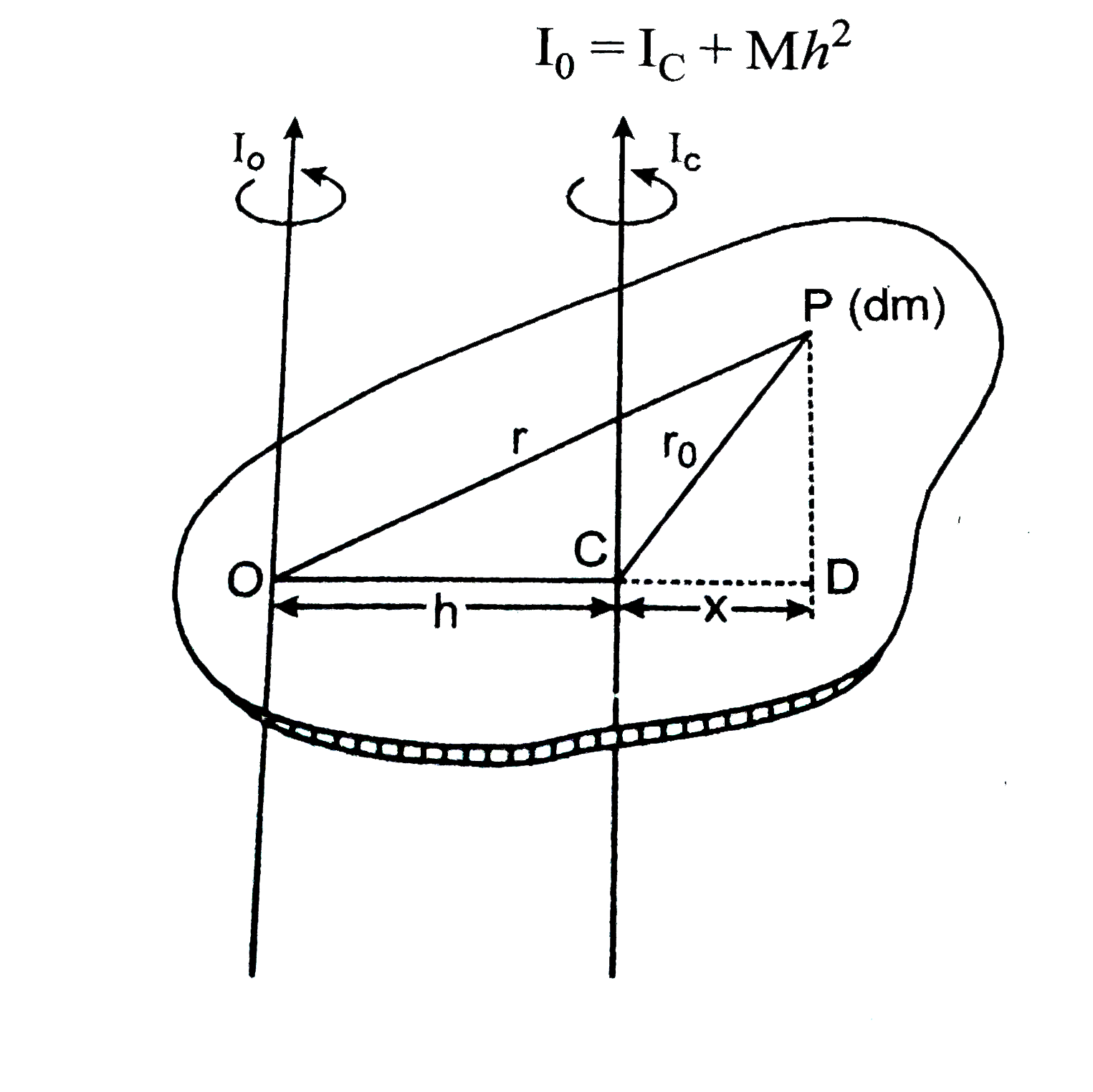State and prove theorem of parallel axes.
Theorem of parallel axes : The moment of inertia of a body about any axis is equal to the sum of its moment of inertia about a parallel axis passing through its centre of mass and the product of tis mass and the square of the perpendicular distance between the two parallel axes.

Consider a rigid body of mass M rotating about an axis passing through a point O and perpendicular to the plane of the figure (a).
Let, I0 be the moment of inertia of the body about an axis passing through point O. Take another parallel axis of rotation passing through the centre of mass of the body.
Let , IC be the moment of inertia of the body about point C.
Let, the distance between the two parallel axes be Oc=h. Take a small element of body of mass dm situated at a point P and OP =r and CP=r0. Join OP and CP, then
From point P draw a perpendicular to OC produced.
Let CD=x
From the figure,
OP2=OD2+PD2
∴OP2=(h+CD)2+PD2
=h2+CD2+2hCD+PD2
∴OP2=CP2+h2+2hCD
(∵CD2+PD2=CP2)
∴r2=r20+h2+2hx
Multplying the above equation with dm on both the sides and integrating, we get
∫r2dm=∫r20dm+∫h2dm+∫2hxdm
∫r2dm=∫r20dm+∫h2dm+2h∫xdm
∫xdm=0 as C is the centre of mass and algebraic sum of moments of all the particles about the centre of mass is always zero, for body in equilibrium.
∴∫r2dm=∫r20dm+h2∫dm+0.....(i)
But ∫dm= M = Mass of the body,
But ∫dm=M = Mass of the body,
∫r2dm=I0 and ∫r20dm=IC
Substituing in equation (i), we get
I0=IC+Mh2
This proves the theorem of parallel axes about moment of inertia.
Topper's Solved these Questions
- BOOK - GURUKUL PUBLICATION - MAHARASHTRA PREVIOUS YEAR PAPERSCHAPTER - FEBRUARY 2016EXERCISE - SECTION-II21videos
FEBRUARY 2016
- BOOK - GURUKUL PUBLICATION - MAHARASHTRA PREVIOUS YEAR PAPERSCHAPTER - FEBRUARY 2014EXERCISE - SECTION-II21videos
FEBRUARY 2014
- BOOK - GURUKUL PUBLICATION - MAHARASHTRA PREVIOUS YEAR PAPERSCHAPTER - FEBRUARY 2018EXERCISE - SECTION-II21videos
FEBRUARY 2018
Similar Questions
Explain what is meant by diffraction of light. Describe a simple experiment to demonstrate diffraction at a single slit.
06:58View SolutionShow that the orbital magnetic dipole moment of a revolving electron isevr/2.
03:50View SolutionThe reflected waves from on ionsphere are ………..
04:44View SolutionState and prove theorem of parallel axes.
View SolutionState and prove theorem of perpendicular axes.
View SolutionState and prove parallel axis theorem
View Solution(a) Prove the theorem of perpendicular axes. (b) Prove the theorem of parallel axes.
03:56View Solution(a) Prove the theorem of perpendicular axes. (b) Prove the theorem of parallel axes.
08:25View Solution(a) Prove the theorem of perpendicular axes.
(b) Prove the theorem of parallel axes.04:19View SolutionState and prove theorem of perpendicular axes.
05:45View SolutionState and prove the principle / Theorem of parallel axes.
08:03View SolutionState Theorem of parallel Axes
04:28View SolutionState parallel axes theorem mathematically?
07:48View SolutionState and prove theorem of parallel axes.
03:17View SolutionState and prove theorem of perpendicular axes.
View Solution

